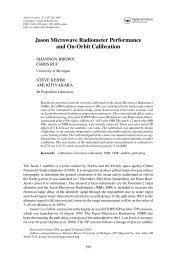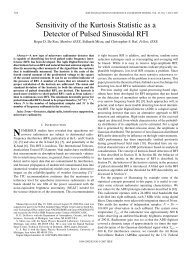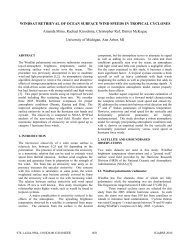The SGR-ReSI and its Application for GNSS ... - IEEE Xplore
The SGR-ReSI and its Application for GNSS ... - IEEE Xplore
The SGR-ReSI and its Application for GNSS ... - IEEE Xplore
Create successful ePaper yourself
Turn your PDF publications into a flip-book with our unique Google optimized e-Paper software.
also demonstrated. Moreover, the collection of signals over<br />
mixed sea <strong>and</strong> ice indicates the potential of <strong>GNSS</strong><br />
Retlectometry <strong>for</strong> ice edge mapping. [6]. <strong>The</strong> UK-DMC<br />
experiment demonstrated the feasibility <strong>for</strong> many remote<br />
sensing applications but limited space-based data is<br />
available <strong>for</strong> robust assessment of the geophysical retrieval<br />
accuracy of <strong>GNSS</strong>-R.<br />
a) It per<strong>for</strong>ms all the core functions of a space <strong>GNSS</strong><br />
receiver, with front-ends supporting up to 8 single<br />
or 4 dual frequency antenna ports.<br />
b) It is able to store a quantity of raw sampled data<br />
from multiple front-ends or processed data in <strong>its</strong> 1<br />
GByte solid state data recorder<br />
c) It has a dedicated reprogrammable FPGA coprocessor<br />
(Virtex 4).<br />
Dual Freq Antennas<br />
V V V V<br />
I LNAs I<br />
Program<br />
SRAM<br />
(1MB TMR)<br />
FLASH<br />
(16MB)<br />
interlink<br />
1 16.367 1<br />
MHz<br />
Reflectometry<br />
Processing Unit<br />
Reprogrammable<br />
Co-processor<br />
SRAM DSP FPGA<br />
8000 7000 .8000 9000<br />
_Hz<br />
' 00<br />
11000<br />
376<br />
378<br />
:;. 380<br />
:E<br />
u<br />
382<br />
8 384<br />
«<br />
u<br />
386<br />
388<br />
-10000 -9000 -8000 -7000 -6000 -5000 -4000 -3000<br />
Doppler Hz<br />
Fig. I Example Delay-Doppler Maps from UK-DMC GPS-R Experiment<br />
a) Ocean reflection, b) sea ice 1 water reflection<br />
3. DEVELOPMENT OF THE <strong>SGR</strong>-RESI<br />
<strong>The</strong> UK-DMC experiment highlighted the potential that a<br />
microsatellite-compatible passive instrument may be able to<br />
make valuable geophysical measurements using GPS<br />
retlectometry. A future experiment would be necessary to<br />
continue the demonstration <strong>and</strong> gather a larger quantity of<br />
data. If possible, the instrument should be capable of<br />
processing the raw data into Delay Doppler Maps in realtime.<br />
Fig. 2 <strong>GNSS</strong> Reflectometry Instrument Configuration<br />
<strong>The</strong> co-processor was specifically included <strong>for</strong> the real-time<br />
processing of the raw retlected <strong>GNSS</strong> data into Delay<br />
Doppler Maps (DDMs) However, it has tlexibility to be<br />
programmed in orbit as required <strong>for</strong> different purposes, <strong>for</strong><br />
example to track new <strong>GNSS</strong> signals, or to apply spectral<br />
analysis to received signals.<br />
For the co-processor to generate Delay Doppler Maps of the<br />
sampled retlected data, it needs to be primed with the PRN,<br />
the estimated delay <strong>and</strong> the estimated Doppler of the<br />
retlection as seen from the satellite. <strong>The</strong>se are calculated by<br />
the processor in conjunction with the main navigation<br />
solution - the data tlow <strong>for</strong> this is shown in Fig. 3. Direct<br />
signals (from the zenith antenna) are used to acquire, track<br />
<strong>GNSS</strong> signals. From the broadcast Ephemerides, the <strong>GNSS</strong><br />
satellite positions are known. <strong>The</strong>n from the geometry of<br />
the position of the user <strong>and</strong> the satellites, the retlectometry<br />
geometry can be calculated, <strong>and</strong> hence an estimate of the<br />
delay <strong>and</strong> Doppler of the retlection.<br />
Surrey teamed with National Oceanographic Centre in<br />
Southampton <strong>and</strong> with other partners, University of Surrey,<br />
University of Bath, <strong>and</strong> Polar Imaging Ltd to develop a new<br />
<strong>GNSS</strong> Retlectometry instrument <strong>for</strong> this purpose.<br />
A schematic of the <strong>SGR</strong>-<strong>ReSI</strong> (Space <strong>GNSS</strong> Receiver -<br />
Remote Sensing Instrument) [7] is shown in Fig. 2. <strong>The</strong><br />
<strong>SGR</strong>-<strong>ReSI</strong> in effect fulfils in one module what might be<br />
h<strong>and</strong>led by three separate un<strong>its</strong> on previous spacecraft.<br />
978-1-4673-1813-6/13/$31.00 ©20131EEE<br />
Fig. 3 <strong>GNSS</strong> Reflectometry Dataflow<br />
<strong>The</strong> processing of the Delay Doppler Map is per<strong>for</strong>med on<br />
the coprocessor using data directly sampled from the nadir<br />
antenna (Fig. 4). In common with a st<strong>and</strong>ard <strong>GNSS</strong><br />
2





